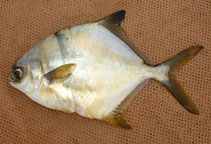| Family: |
Carangidae (Jacks and pompanos), subfamily: Trachinotinae |
| Max. size: |
68 cm TL (male/unsexed); max.weight: 7,900.0 g |
| Environment: |
pelagic-neritic; freshwater; brackish; marine |
| Distribution: |
Eastern Atlantic: Senegal to Gabon, including Cape Verde (Ref. 4225, 57392, 81654). |
| Diagnosis: |
Dorsal spines (total): 7-7; Dorsal soft rays (total): 19-21; Anal spines: 3-3; Anal soft rays: 16-18. Diagnosis: body short and deep (depth comprised 1.8-2.5 times in fork length)(Ref. 57392, 81654). Snout rounded; mouth small; maxillary reaching to below hind margin of pupil (Ref. 57392). No teeth on tongue (Ref. 81654). 2 dorsal fins, 1st with 6 spines, 2nd with 1 spine and 19-21 soft rays; anal fin with 2 short, detached spines followed by 1 spine and 16-18 soft rays (Ref. 57392, 81654). Soft dorsal (Ref. 57392, 81654) and anal fin lobes shorter than head (Ref. 57392). Pectoral fins short; scales small, cycloid and partially embedded in skin; lateral line very slightly arched over pectoral fins, without scutes (Ref. 57392). No distinct spots/dark blotches (Ref. 57392, 81654) or other colour marks on body (Ref. 57392).
Coloration: back bluish-grey or greenish, sides and ventrum silvery, without distinctive markings; fins dark; lobes of dorsal, anal and caudal fins darker to black (Ref. 57392, 81654). |
| Biology: |
Adults inhabit coastal waters (Ref. 2683). Enters brackish waters for reproduction and ascends rather far up the lower courses of rivers (Ref. 4225, 57392). Unique in spending the whole live cycle in myxohaline environment, without a marine phase; seasonality of recruitment seems to indicate that favourable conditions for reproduction and larval survival are limited to the dry season although sexual maturity occurs all year round (Ref. 81654). Feeds on fry and young shrimps up to 125 mm fork length, diet of larger specimens mainly malacophagous (bivalves), the shells of which are crushed with well-developed pharyngeal jaws (Ref. 81654). Also feeds on fish, shrimps and crabs (Ref. 28587). Maximum fork length recorded was 610 mm (Ref. 57392). |
| IUCN Red List Status: |
Least Concern (LC); Date assessed: 10 May 2013 Ref. (130435)
|
| Threat to humans: |
harmless |
| Country info: |
|
Source and more info: www.fishbase.org. For personal, classroom, and other internal use only. Not for publication.

